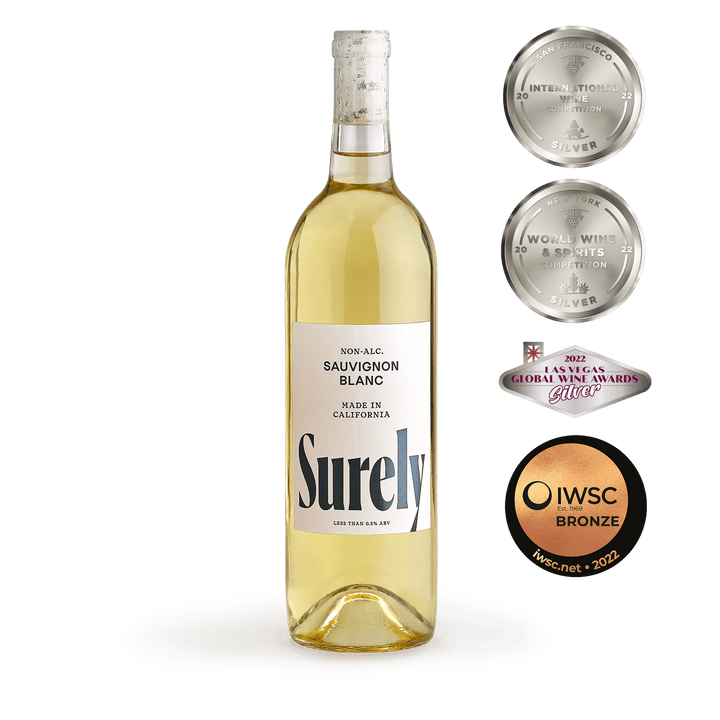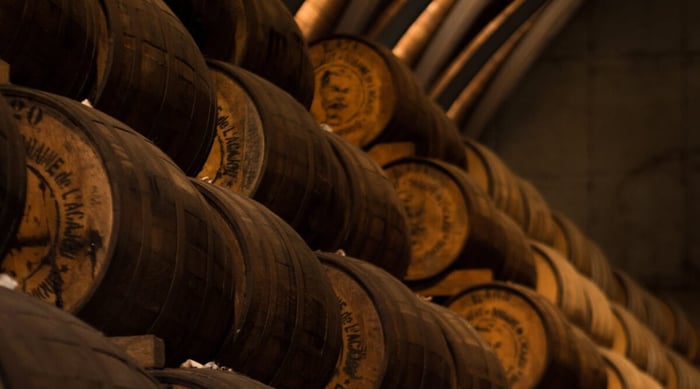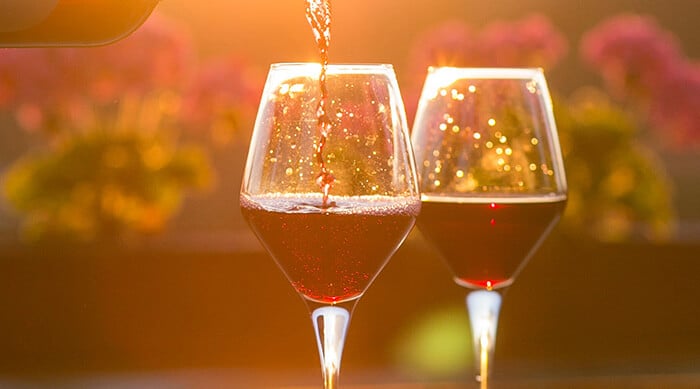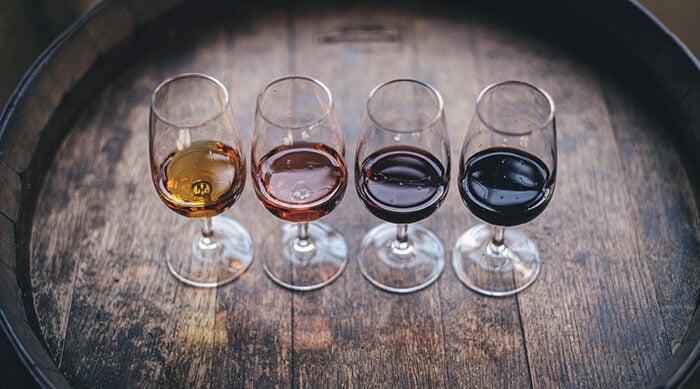You don’t need to be a wine enthusiast to understand wine basics.
What are the wine basics? Knowing your wine basics includes understanding the main characteristics of wine, differentiating between varietals, and learning more about your own palate.
Outside of those basics, quite a bit about enjoying wine that is subjective. Our Wine 101 guide should lead you through starting your own wine journey.
Table of Contents
What is wine?
At its most basic, wine is a beverage made from fermented grapes.
The difference between old world and new world wine is simple. Old world wine comes from regions where winemaking first originated. That includes France, Italy, and Spain.
New world wine winemakers got their start by learning from the originators. That includes wine regions in the United States like California, Australia, and countries in South America. Check the label if you’re not sure where a wine comes from.
What is the difference between wine and grape juice? The difference between wine and grape juice is in the fermentation process, use of yeast, and sugar content. Grape juice is unfermented with a much higher sugar content.
The use of yeast allows fermentation to happen, but it also adds to the character of the wine.
Note: While wine is usually an alcoholic beverage, dealcoholized varieties are becoming more popular. The wine starts off the same way, with the alcohol removed at the end. It’s part of a movement to be more mindful about drinking and make healthier choices.
Table of Contents
Wine Characteristics
Many people drink wine just because they like it, but there are 5 unique wine characteristics that you can target at your next wine tasting to further develop your palate.
What are the 5 basic wine characteristics? The 5 basic wine characteristics are sweetness, acidity, tannin, alcohol, and body.
Sweetness
Sweetness refers to the residual sugars left behind in a wine. This doesn't necessarily mean you’re drinking a dessert wine, although if a wine is obviously sweet, that could very well be the case.
Some dry red wines have a high amount of residual sugar, too. That typically means they’re lower quality, though, and that sugar is masking something else that would be undesirable.
If you’re tasting for sweetness, here’s what to look for:
- Does the tip of your tongue tingle after that first sip? That’s a sign of sweetness.
- An oily feeling on your tongue can also signal sweetness.
- Tip the wine over a bit, swirling it around the inside of your glass. Sweet wines have a higher viscosity, or thickness. They’ll cling to your glass in a more obvious way.
Acidity
Wines high in acidity are often described as tart, zesty, or even a little sour. A great wine has a balance of sweetness and acidity. Neither overpowers the other.
Your mouth puckering after that first sip is a classic sign of high acidity in a wine. Here are a few more things to look for:
- The sides of your tongue are tingling rather than the tip.
- If you run your tongue along the roof of your mouth, it feels rough.
- Your mouth feels like it’s producing more saliva than usual, as if you just bit into a juicy apple.
Tannins
Tannins are a class of phenolic compounds that add bitterness or astringency where they appear, in this case, in wine.
They’re found in both red and white wine, but bold red wines are much higher in tannins. Cabernet Sauvignon, Bordeaux wines, and wines made from Sangiovese grapes are all high-tannin.
If you’re not sure whether a wine is high-tannin, here’s what to look for:
- Your tongue feels dry after that first sip.
- You taste a lingering bitterness on the tip of your tongue.
- The flavor seems to stay with you longer than with other wines.
Alcohol
The average glass of wine has about 11-13% alcohol by volume (ABV), but some wines are much lower and much higher in alcohol than that. Typically, high-alcohol wines are deep reds or fortified ports.
Note: Whether you’re watching your wine calories or moderating your drinking, a standard pour of wine is 5 oz. A bottle of wine has about 5 standard pours of wine. A standard pour of fortified wine with a high ABV will be lower at around 3 oz.
If you’re unsure whether you’re tasting a high-alcohol wine, watch for the following:
- The first sip warms the back of your throat.
- The wine tastes bold, maybe even a little oily.
- A light, more effervescent wine typically has a lower ABV.
Body
Wine body refers to several factors that add to a wine’s richness. A full-bodied wine is typically lower in acidity, high-tannin, and higher in alcohol.
Use these tasting notes to see if you’re sipping a full-bodied wine:
- The wine’s taste lingers on your palate.
- Plentiful tannins make your mouth feel dry.
- Check the wine label. Full-bodied wines have higher ABVs.
Read Next: Why Wine Causes Bloating & How to Prevent It
Types of Wine
Wine types vary based on both grape varieties and the wine regions that grow the grapes.
What are the different types of wine? The different types of wine include red wine, white wine, rosé, sparkling wine, dessert wines, and fortified wines.
There are some shared characteristics with varietals in each type of wine, but there can also be quite a bit of variation.
A chardonnay, for example, is often considered a buttery, full-bodied white wine. Some modern winemakers have turned that perception onto its head, putting up chardis that are higher in acidity.
Let’s take a look at some of the most popular wine varietals out there and what you should expect from a typical taste test.
Red Wines
Red wines are fermented with dark-colored grape skins. That means they’re higher in resveratrol, a known antioxidant found in grape skins and tannins. If your red wine tastes a bit too bitter, try aerating the wine, or giving it some air to mellow out.
Interested in a food pairing? Pair red wines with hearty meals. Red meat, pasta, even pizza all work well with a glass of red wine.
- Cabernet sauvignon: Bold, full-bodied, high-tannin
- Pinot noir: Dry, light, approachable
- Merlot: Fruit-forward, medium body, low-tannin
- Malbec: Full-bodied, rich fruit flavor, medium acidity
- Syrah: Full-bodied, fruit-forward, popular in blends
White Wines
Most white wines are made with white grapes, but that’s not true for all varietals. The difference in winemaking with white wines is that the grape skins are removed before fermentation. Most are served chilled before drinking.
Seafood, chicken, and cheese plates all pair well with most white wines.
- Chardonnay: Creamy, buttery (oaked), citrus-forward (unoaked)
- Sauvignon blanc: Light, herbaceous, citrus-forward
- Riesling: Sweet, fruity, high acidity
- Pinot Grigio: Light, crisp, fruity
- Viognier: Rich, floral-forward, medium-body
Rosé Wines
Rosé wines are made with darker grape skins, but for a shorter period than red wine. The broad range of grapes used with rosé means they come with a variety of flavor profiles, so there isn’t one varietal known for rosé wine.
Rosé wine typically boasts more health benefits than white wine, including a resveratrol boost. That’s thanks to those grape skins used during the fermentation process. Serve rosé with light snacks and charcuterie plates for the perfect night in.
Sparkling Wines
Sparkling wines can be made of red or white wine grapes. They’re unique for their fizz and light-bodied flavor. Serve bubbles with seafood, light snacks, or as the first toast at your next celebration.
- Champagne: Citrus-forward, zesty, traditionally from Champagne, France
- Prosecco: Fruity, floral, traditionally from Italy
- Cava: Light-bodied, dry, traditionally from Spain
Dessert Wines
Dessert wines achieve their sweetness in different ways. Winemakers may use grapes known for natural sweetness or adjust fermentation to account for higher residual sugars.
Some lower-quality wine producers add sugars to their dessert wines, so you’ll want to read wine labels closely for that tactic.
Serve them with, you guessed it, your favorite dessert.
- Moscato: Floral, fruity, low acidity
- Chenin blanc: High minerality, honey notes, higher acidity
- Gewurztraminer: Rich, low acidity, candy aromas
Fortified Wines
Fortified wines are often lumped in with dessert wines, but the addition of distilled spirits like brandy to the process gives them a more robust, more unique flavor. Serve them chilled as an after-dinner drink.
- Port: Fruit-forward, medium tannins, full-bodied
- Sherry: Dry, savory, nutty
- Madeira: Dry, rich, full-bodied
What is the best wine for beginners? The best wine for beginners is typically a smooth varietal low in tannins and acidity. Pinot noir, a crisp sauvignon blanc, even sparkling wines are all approachable for wine drinkers seeking an intro to wine.
From there, wine tasting becomes about your personal preference. You may find that you like bold reds from the start or that you don’t like wine unless it’s fruit-forward. A great bottle of wine for you is simply any wine you enjoy.
Nutrition
Wine is typically considered better for you than most alcoholic beverages. Red wine, in particular, is a good source of resveratrol, a known antioxidant linked to improved heart health and anti-aging effects. It’s why some consider red wine a functional beverage.
Red and white wines are similar in calories per ounce. Sparkling wine is generally lower in calories. Wine is also relatively low in carbs and acceptable on most low-carb diets, like keto.
All that said, if you’re not already drinking wine, you shouldn’t start drinking just because of the purported health benefits. Not drinking at all is healthier than even moderate drinking. Non-alcoholic wine is an excellent option if you’re seeking a healthier wine.
Non-Alcoholic Sauvignon Blanc

$22.99
Award-winning alcohol-removed California Sauvignon Blanc. Citrus meets pear and apple to create a crisp, bright, dry sip. TASTING NOTES: This perfectly balanced, dry Sauvignon Blanc is citrus-forward with soft pear and sweet apple notes. FOOD PAIRINGS: The perfect companion to… Read More
Read Next: The Dos and Don'ts of Mixing Wine and Tylenol
Housekeeping
Whether you’re thinking about keeping a few varietals on hand to impress potential guests or just want to add to your wine knowledge, here are a few FAQs when it comes to wine keeping wine.
What’s the ideal temperature for wine?
Serve red wines a few degrees cooler than room temperature. Serve white wines a few degrees warmer than your fridge temperature. The ideal storage temperature for any wine is 55°F.
How should I store my wine?
Store your wine on its side to keep the wine cork moist. If you’re drinking the wine within a few days, it’s ok to leave it upright.
How long can I keep an unopened bottle of wine?
Most quality wines can last for several years as long as they’re stored correctly. You’ll know wine has gone bad once you open it by the sour, vinegary smell coming off the bottle.
How long can I keep an opened bottle of wine?
Drink an opened bottle of wine within 3-5 days after opening if you’ve resealed it properly. A wine left exposed to the air may only last a day before its taste is affected.
How do I reseal a bottle of wine?
One of the most common wine storage mistakes is a lack of proper sealing after opening a bottle. As long as the cork isn’t damaged, use the original cork to reseal a bottle of wine. Otherwise, wine stoppers are another good option to slow oxidation.
Why does wine cost so much?
Smaller batch wineries charge more per bottle to cover higher production costs. Vintages that need time to age, pricier varietals, and high demand also drive up prices.
That doesn’t mean you need to take out a mortgage to buy quality wine. Some wineries cut costs with simpler labels, screw caps, and lower marketing costs. None of that necessarily means you’re drinking low-quality wine.
Essential Terms
If you’re new to wine, learning wine vocabulary can feel overwhelming. Here are a few terms we haven’t already covered:
Aromas: The smell of the wine in a glass
Balance: The 5 characteristics of wine come together in a positive way
Bouquet: A way to describe a wine’s aromas
Brut: French for dry, typically used to describe dry Champagne or sparkling wines
Complex: A wine with a variety of flavors and aromas, from start to finish
Enology: The study of wines
Fining: Clarifying or purifying wine to remove any unwanted particles
Mouthfeel: The sensation or texture of wine in your mouth, e.g., “smooth” or “chewy”
Nose: The aromas and smells that come off a glass of wine
Oxidation: A series of chemical reactions when wine is exposed to air
Sommelier: A trained wine expert, or wine steward
Terroir: Wine characteristics that relate to the region and natural environment where a varietal is produced
Now that you can fancy yourself a more-than-basic wine drinker, it’s time to find the type of wine you like best. If you’re trying to cut back on alcohol, you can still use your new wine knowledge to taste-test the best dealcoholized wines out there.
Surely non-alcoholic wine offers wine that tastes like the real thing because it is the real thing. We start with the best grapes to give you delicious non-alcoholic reds, sparkling white wines, even pink rosés to meet any wine palate.




